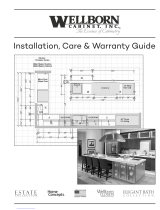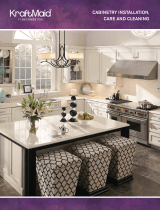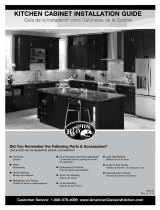
All electrical connections must be done by a
qualified electrician.
Press a ruler against your worktop with a
G-clamp to ensure you saw it to the right
length with a circular saw. Placing your
worktop on a sawhorse will make your
work easier. Tip: have someone hold the
piece you’re sawing off in place to prevent
splintering.
Apply polyurethane silicone along the sawn
edges to prevent moisture from penetrating
the worktop.
Installing lighting and appliances. When
drilling holes, use a piece of wood to
prevent splintering when the bit penetrates
the surface.
Lower the sink into the worktop in
accordance with the assembly instructions.
Measure the worktop again. If you have bought
a standard worktop, you should cut it to the
right length now. When using a circular saw or
a fretsaw, turn the worktop over so the bottom
is facing upwards. When using a handsaw, turn
the worktop the right way up, so the top is
facing upwards.
Place the worktop in its final position to
mark off where the sink will be. Trace the
inside of the base cabinet on the underside
of the worktop to help you align the cut-out
for the sink. Turn the worktop over and trace
the outline of the sink onto masking tape.
Secure the worktop in place in accordance
with the assembly instructions.
Use a jigsaw to saw the cut-out for the
sink. Drilling holes in the corners inside the
outline before you start sawing will help you
make a neater job of it.
Make a cut-out on your worktop for the
hob like you did for the sink. Check the hob
assembly instructions for directions.
Install the extractor hood. IKEA extractor
hoods can be installed in two ways: vented to
the outside, i.e. in extraction mode; or fitted
with a charcoal filter in recirculation mode.
Both options are described in the assembly
instructions that come with the product.
Saw the hole in the back panel or in the
top of the cabinet. Check the assembly
instructions. For the sake of safety and
functionality, you must stick closely to the
instructions for taking measurements when
installing the extractor hood.
Installing a worktop, sink, lighting
and appliances.
Now the cabinets are installed, you can get to work
on your worktop, sink, lighting and appliances. Before
you start, check the worktop has the right dimensions.
If you need to saw cut-outs in your worktop for a sink
or hob, you should do that now. Note! Always use the
assembly instructions as a guide.
Once the worktop is in place, you’re ready to connect
the water, gas, lighting and appliances. All water, gas
and electrical connections must be done by qualied
people in accordance with all local safety regulations.
Kitchen island
Are you installing a kitchen island? We have the fixings you need to firmly
anchor it in the floor. Legs and plinths must then be placed around the
outside.
You can use UTBY legs or the METOD kitchen island assembly kit. The kit is
used to connect the cabinets back to back or attach a cover panel to the back
of the cabinets.
Contact your IKEA store for help with assembly or installation.
98
METOD kitchen island assembly kit. 202.984.10
7,-
Good to know
When installing a kitchen island, you must anchor
it in the floor with UTBY legs or by building a
plinth frame. In that case, the plinth frame must
be anchored in the floor and the cabinets must be
assembled on top of this. Take care with underfloor
heating or water pipes when anchoring the kitchen
island in the floor.












